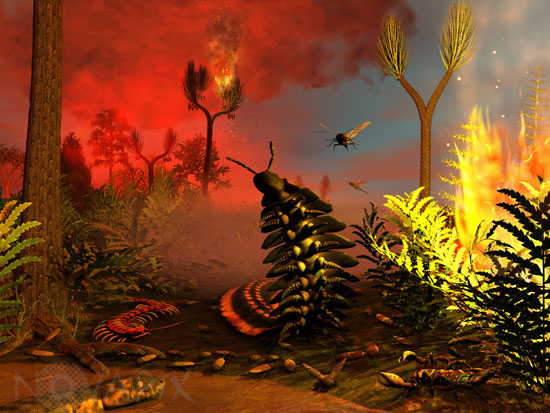Photo Agency - Astronomy - Space - Nature

Carboniferous firestorm
author: Walter B. Myers/Novapix
reference: t-glb91-04007
Image Size 300 DPI: 25 * 19 cm
Fire rages through a prehistoric forest of towering Sigillaria and Cordaites, Asterophyllites, Calamites, and ferns. In the foreground a potpourri of giant Carboniferous invertebrates flee the conflagration, heading for the only real estate not subject to burning: water. On the left is a giant, 3 foot centipede; in the center is a giant Arthropleura, the largest known arthropod ever to walk the earth; on the right is a two-foot-long scorpion, and in between are dozens of prehistoric "roachoids," some taking briefly to the searing air. On the far left submerged in the relative comfort of the water is a Dendrerpeton awaiting the prospect of an easy meal.
300 million years ago the Earth's atmosphere may have held considerably more oxygen than today; the air may have been as much as 35% oxygen (the air we breathe now is 21% oxygen). Such high oxygen levels may help to explain why so many terrestrial invertebrates--insects, arachnids and some crustaceans--grew to such enormous sizes. These invertebrates "breathe" by adsorbing oxygen directly through their skin. Another consequence of such an oxygen-rich environment would be an increased propensity for organic matter to combust. Forest fires sparked by lightning or volcanic activity must have burned with a special ferocity.
Keywords for this photo:
2012 - ANIMAL - ARTHROPOD - CALAMITE - CARBONIFEROUS - EARTH - FAUNA - FERN - FIRE - FLORA - FOREST - HISTORY OF EARTH - ILLUSTRATION - INSECT - PALEOZOIC - PLANT - WATER -
Contact : Stéphane Aubin +33-(0)9-51-26-53-76
© Novapix - All rights reserved


